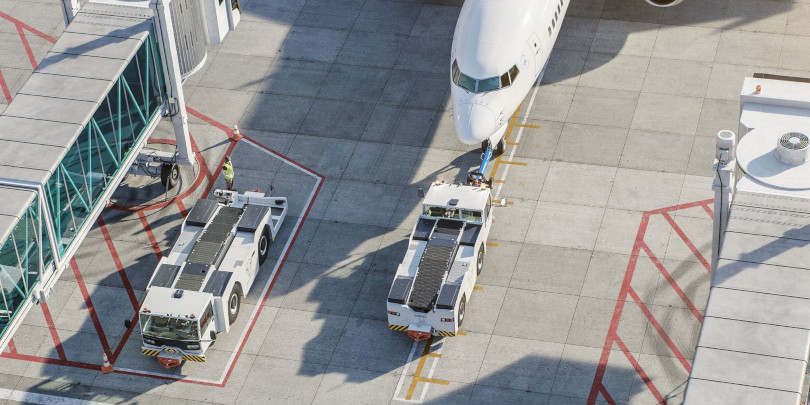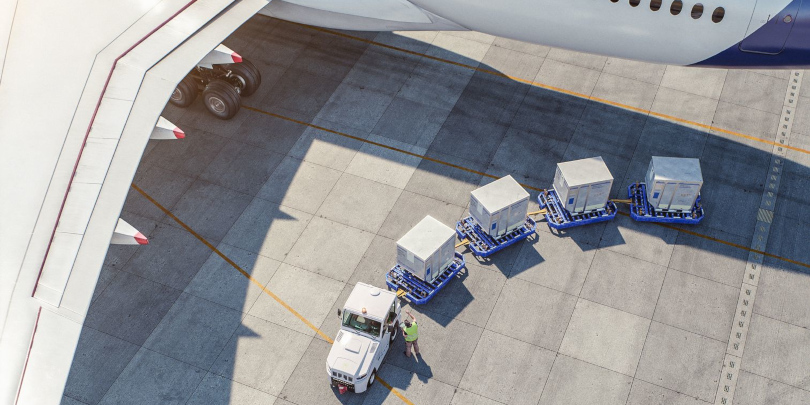
Bavarian Power: Strategic Partnership
Founded in 1705 as a blacksmith’s shop, Goldhofer today operates as a manufacturer of robust and intelligent transport solutions for heavy-duty and special-transport purposes – on and off the road and at the airport.
At their Memmingen headquarters in Bavaria, Goldhofer builds vehicles with a payload ranging from 25 t to over 15,000 t.
Goldhofer started venturing into the field of electrification as early as the early 1980s. “However, it was the supranational environmental policies and the demand brought forward by certain airports and, of course, the market in general that ultimately swayed our decision in 2017 to delve deeper into this new technology and consider additionally offering electric versions of our new ground support equipment products,” explains Rüdiger Dube, Head of Product Management Airport Technology at Goldhofer.
The advantages of an electrically powered cargo tractor over one with an internal combustion engine are numerous: reduced CO2 emissions, lower noise emissions, less local particulate pollution, a more pleasant driving experience (as there is no longer a need to shift gears), a significantly more positive torque curve and equivalent performance. Moreover, electric tractors are less maintenance-intensive. “An airport, by the way, is a great environment for electric vehicles, as they are not required to cover long distances and constantly pass by the charging station. It is our assumption that electrified ground support equipment at airports will rise above their niche status,” adds Jochen Preßmar, Senior Project Engineering Manager for Electric Vehicles at Goldhofer.

Jointly Contributing to Emission-Free Airports
Various programs around the world illustrate: It has become the declared goal of many airports to become emission-free within the next few years. Webasto and Goldhofer have teamed up with the intention to help turn this plan into reality. Together, the two companies are bringing the optimized cargo and pushback tow tractor “SHERPA” E New Gen to airport roads. Since 2017, the “SHERPA” E has already been providing quiet and emission-free operation on airport aprons around the world.
Some 30 tons of CO2 per annum can be saved by using it compared to the fuel-powered version of the tractor. When incorporated into an intelligent charging infrastructure, it prevails over conventional diesel-powered cargo tractors in the areas of performance, flexibility, sustainability and economy. Besides an expanded performance range and extended service life, the enhanced version can be charged more quickly and with greater flexibility and provides for longer maintenance cycles and lower operating costs.
Unlike its predecessor, the new model now comes with a gearless direct drive that generates a torque of up to 1,050 Nm. It is supplied with power by a modular battery system with intelligent temperature management.

On the Right Path to the Perfect Battery Match
During their search for the right partners and best-fitting products for the »SHERPA« E, Goldhofer primarily focused on such factors as quality and reliability. “Imposing exacting requirements and placing prime importance on the quality and longevity of our vehicles, we take great care to only use components that offer great promise and that allow us to maintain our high standard of quality,” declares Preßmar.
When Goldhofer tried to find the right battery supplier, they quickly landed on Webasto. “Depending on the version and in line with the customer’s specific requirements, we equip the »SHERPA« E with one or two Webasto batteries, each generating 35 kWh,” explains the Senior Project Engineering Manager. When selecting the battery, Goldhofer took various key aspects into consideration. One of the most important was that the battery systems are of modular design, which allows them to be used across various different vehicles. “We have diverse vehicle ranges of different sizes and requirement levels.
We identified Webasto as an all-rounder for the “SHERPA” and “BISON” product segment, which offers us as a company the option of modular construction,” is how Rüdiger Dube describes the decision-making process. For Goldhofer, it was also important for the batteries to already be approved for road use, which is the case here, as they have been subjected to electromagnetic compatibility testing and therefore do not interfere with radio or electronic components.

Battery Technology, Service Life and Integration
While not giving any general preference to one battery technology over the other, Goldhofer currently regards lithium-nickel-manganese-cobalt-oxide batteries as the most efficient. “The need to save space is of enormous consequence to us as the vehicles are supposed to be as compact as possible. Compared to lithium-nickel-manganese-cobalt-oxide batteries, the energy density offered by iron-phosphate technology is approximately one third less.
We realized relatively quickly that it was pivotal for us to fit our vehicles with the battery that offers the highest energy density available on the market today. It is our hope that energy density on the cell level will keep increasing in the future,” stresses Jochen Preßmar. With regard to battery service life, Goldhofer is currently aiming for at least eight years. After that time, the battery should still deliver significantly more than two thirds of its original output capacity. “It remains to be seen if the customer will actually switch batteries or merely opt to make slight variations to their cycle,” notes Preßmar. “However: When battery doesn’t have its original capacity anymore, does that mean the battery is ready to be discarded? No, it still can be used, but serving a different purpose in a second-life application, e.g. as a stationary or mobile buffer storage battery,” points out Dube.
When it comes to the service life of the battery, it will be necessary to gain more experience and perform additional analyses in an effort to produce improved benchmarks and make statements with greater certainty. Experience and evaluations will also play a role in the integration of the batteries in future projects. The mechanical integration plus coolant supply and high-voltage connection went off without a hitch in the »SHERPA« E, allowing us to implement everything by our deadline. “Webasto was there for us at every step of the development process. We even exchanged data collected during the trial phase and continue to meet on a regular basis to make sure we always know exactly what the other partner’s status is. I believe that Webasto is a dependable partner that will allow us to keep pushing our development forward.”

Joint Path Into the Electric Future
Together, Webasto and Goldhofer intend to continue supporting airports on their way to achieving zero emissions. “We are very pleased to have gained a strong and experienced partner in Goldhofer, with whom we can drive forward electrification in the field of ground support equipment, thereby making our contribution to achieving emission-free airports around the world. In order to be able to meet the ever-increasing demands on electric ground support vehicles we will continue to offer, and constantly expand, a comprehensive portfolio of solutions for electric vehicles.
As a driver of electromobility, Goldhofer plays a key role in stimulating us to develop future products for electric vehicles in the airport sector that meet market requirements as closely as possible,” says Manuel Kagelmann, Head of Product Portfolio Domain Batteries at Webasto, looking to the future. Jochen Preßmar of Goldhofer adds: “We are, of course, thrilled to be one of the first manufacturers to offer highly attractive electric variants in the cargo and pushback tractor segment. The trend toward zero-emission drive systems is highly dynamic and irreversible.”
